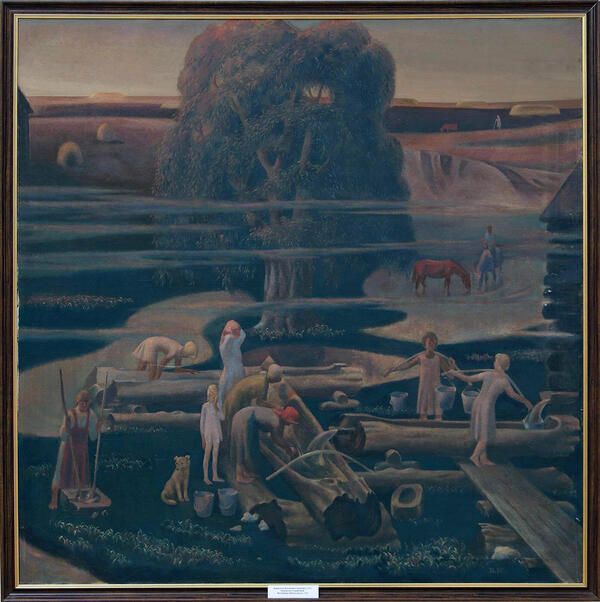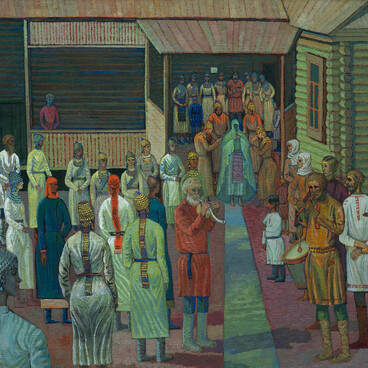Vladimir Semyonovich Karandayev was born in 1939 in Arkhangelsk. He graduated from the Cheboksary Art College in 1967, and later from the Surikov Institute, and studied under such artists as Dmitry Mochalsky and Gennady Korolev. Until the mid-1980s, he lived and worked in Chuvashia. Karandayev was a member of a creative team of artists who depicted the construction of an industrial tractor plant in Cheboksary (“And Star Speaks with Star…”). The artist also made creative trips to Kamchatka and the Amur region. After that, he lived in Moscow. After 1987, he taught at the 1905 Memorial School of Art. He was a member of the “Moskvorechye” creative association.
Karandayev’s creative career began during the heyday of the “austere style”. His 1970s works can also be attributed to this style, both in terms of subject matters and style. Using a restrained color palette, built on a combination of grayish-green, dark blue, and brown, his paintings reveal the true heroism of fishermen, polar pilots, lumberjacks, reindeer herders, and inhabitants of small taiga villages — people are constantly faced with the harsh conditions of the northern climate in their work and everyday life.
In the first half of the 1980s, the artist focused his attention on Chuvashia with its simple countryside life. He still used a limited color palette, with such colors as gray, brown, and greenish with small inclusions of red. Even for an ethnic still life, the painter chose to forgo bright embroidered towels and shiny silver jewelry but instead depicted baskets with cones and mushrooms. Despite demonstrating the austere reality of the world around him, Karandayev showed that, whether in the taiga or at a large-scale construction project, there is always a place for a personal relationship, care, and tenderness.
“Spring Under the Old Willow” creates a scene of a harmonious countryside life where things have remained unchanged for many years. The artist shows girls, young women, and children living a rural life: they draw spring water from wooden troughs, carry it with yokes, wash and rinse linen in an old-fashioned way, while young men herd horses in the field at night.
The imagery used by the artist can be considered archetypal for Chuvash art: despite their realistic nature, they acquire symbolic meaning.
Karandayev’s creative career began during the heyday of the “austere style”. His 1970s works can also be attributed to this style, both in terms of subject matters and style. Using a restrained color palette, built on a combination of grayish-green, dark blue, and brown, his paintings reveal the true heroism of fishermen, polar pilots, lumberjacks, reindeer herders, and inhabitants of small taiga villages — people are constantly faced with the harsh conditions of the northern climate in their work and everyday life.
In the first half of the 1980s, the artist focused his attention on Chuvashia with its simple countryside life. He still used a limited color palette, with such colors as gray, brown, and greenish with small inclusions of red. Even for an ethnic still life, the painter chose to forgo bright embroidered towels and shiny silver jewelry but instead depicted baskets with cones and mushrooms. Despite demonstrating the austere reality of the world around him, Karandayev showed that, whether in the taiga or at a large-scale construction project, there is always a place for a personal relationship, care, and tenderness.
“Spring Under the Old Willow” creates a scene of a harmonious countryside life where things have remained unchanged for many years. The artist shows girls, young women, and children living a rural life: they draw spring water from wooden troughs, carry it with yokes, wash and rinse linen in an old-fashioned way, while young men herd horses in the field at night.
The imagery used by the artist can be considered archetypal for Chuvash art: despite their realistic nature, they acquire symbolic meaning.



